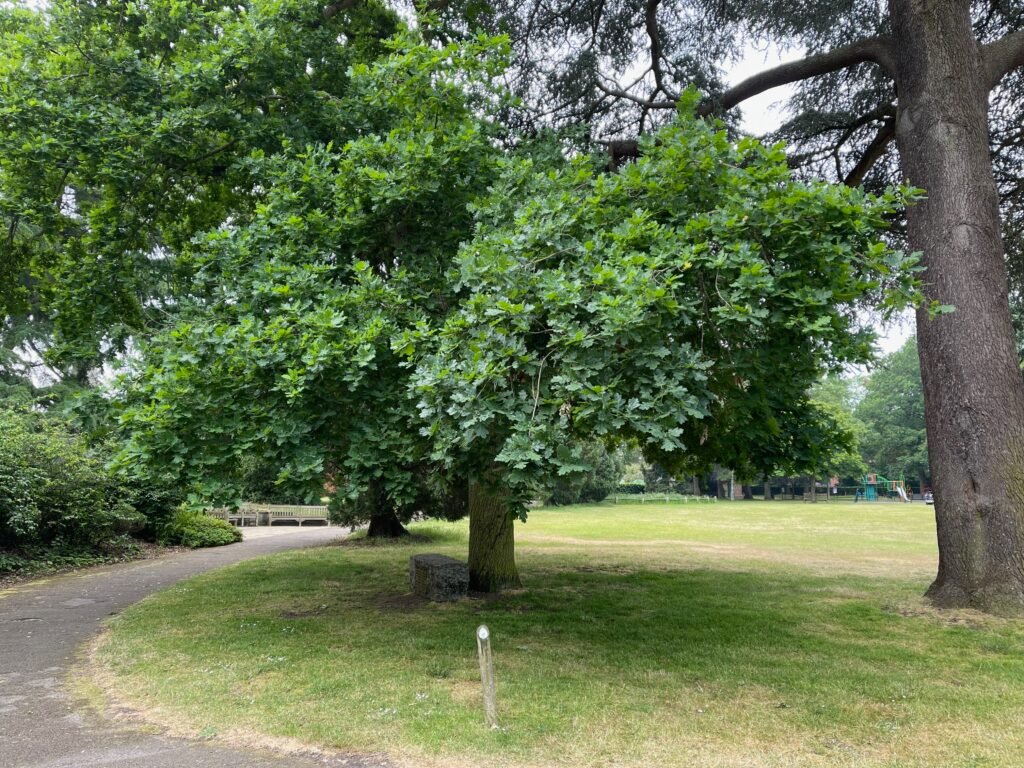Oak, English
The English Oak, the majesty of the woods, is a broadleaved deciduous tree, that can grow to a height of 40m, and may live for 1,000 years.
This species grows and matures to form a broad and spreading crown with sturdy branches beneath.
This tree was planted in memory of Mr Edward Holmes, who was the Trustees’ Clerk from the Gardens’ opening in 1888 until his death in 1908.

Photo supplied by: Alan Payne
Common Name:
English Oak
Scentific Name:
Quercus robur
Tree No:
143
Location:
L12

The leaves are round 10cm long with 4–5 deep lobes with smooth edges. Leaf-burst occurs mid-May and the leaves have almost no stem and grow in bunches.

Credit: This could be your image
Long, yellow hanging catkins which distribute pollen into the air.

Credit: This could be your image
The fruit is an acorn. The acorns are 2–2.5cm long, on long stalks and in cupules (the cup-shaped base of the acorn). As it ripens, the green acorn turns brown, loosens from the cupule and falls to the canopy below, sprouting the following spring.

Credit: This could be your image
English Oak is native to the UK. It is especially common in deciduous woods in southern and central Britain. In fact, it’s so frequent that it has assumed the status of a national emblem.
Oak forests support more life forms than any other native forest. They are host to hundreds of insect species, supplying many birds with an important food source. In autumn, mammals such as squirrels, badgers and deer feed on acorns.
Flower and leaf buds of English oak are the food plants of the caterpillars of butterflies.
The soft leaves of English oaks break down with ease in autumn and form a rich leaf mould beneath the tree, supporting invertebrates such as the stag beetle, and fungi, like the oak bug milk cap. Holes and crevices in the tree bark are perfect nesting spots for the pied flycatcher, redstart or marsh tit.
Oaks produce one of the hardest and most durable timbers on the planet. However, it takes up to 150 years before an oak is ready to use in construction. It has been a prized hardwood timber for thousands of years and is still used for wood framed buildings, doors, flooring, and furniture, as well as wine and sherry barrels, which are subsequently used for aging whisky.
An ancient example of Oak framed buildings can be seen at Cressing Temple Barns, where the Oak framed barns were built in the 13th century.
Ash, Elm and Oak, were used in the manufacture of cart wheels.
Oak is used for the spokes, because it doesn’t bend, compress or flex and transfers any load pressures directly from the felloes (rim) to the nave (hub).
It is interesting to see the difference of this tree from the Oak tree, planted 20 years before the Memorial Oak near the café. It is a much poorer specimen, due to the fact it was planted too close to the cedar – it is struggling to get up into the day light.
It goes to show how important it is, when planting trees, to consider how they will fare when their neighbours grow up!
Tree Listings
Wild Cherry
Cherry, Wild The Wild Cherry, one of the prettiest native trees, is a broadleaved deciduous tree, that can grow to a height of 30m, and may live for 60 years. The shiny bark is a deep reddish-brown with prominent cream-coloured horizontal lines called lenticels. ...
Western Red Cedar
Cedar, Western Rad The Western Red Cedar, is an giant evergreen conifer, that can grow to a height of 65m, and may live for 1,000's of years, with several examples in existance that over 1,500 years old. It is tall and conical in shape, with a broad trunk and dense...
Japanese Red Cedar
Cedar, Japanese Red The Japanese Red Cedar, is an evergreen conifer, that can grow to a height of 65m, and may live for 350 years. The bark is grey and stringy and tears off in long strips on mature trees..Photo supplied by:Common Name:Japanese Red Cedar Scentific...
Deodar Cedar
Cedar, Deodar The Deodar Cedar, is a fine textured evergreen conifer, that can grow to a height of 50m, and may live for 1,000 years.These two Deodars were probably planted well before the Gardens opened in 1888.Photo supplied by:Common Name:Deodar Cedar Scentific...
Blue Atlas Cedar
Cedar, Blue Atlas The Blue Atlas Cedar, is a showy evergreen conifer, that can grow to a height of 35m, and may live for 150 years. The trees are pyramidical while young but with age become flat topped with horizontal branches. The bark is blackish-brown with closely...
Silver Birch
Birch, Silver The Silver birch, is a striking broadleaved deciduous tree, that can grow to a height of 30m, and may live for 150 years, although 60 to 90 years may be more typical. Forming a light canopy with elegant drooping branches. The silver-white bark sheds...
Cut Leaf Beech
Beech, Cut Leaf Content to follow. Photo supplied by: Alan PayneCommon Name:Cut Leaf Beech Scentific Name:Fagus sylvatica heterophylla asplenifoliar Tree No:186 Location:D7Content to follow. Credit: This could be your image Content to follow....
Copper Beech
Beech, Copper The Copper beech, also known as purple beech, is a broadleaved deciduous tree, that can grow to a height of more than 40m, and may live for 300 years, although 200 years may be more typical. The bark is smooth, thin and grey, often with slight horizontal...
Common Beech
Beech, Common The Common Beech, is a charismatic and beautiful broadleaved deciduous tree, that can grow to a height of more than 40m, and may live for 350 years, although 250 years may be more typical. The bark is smooth, thin and grey, often with slight horizontal...
Common Ash
Ash, Common The Common Ash, is a broadleaved deciduous tree, that can grow to a height of 35m, and may live for 350 years, although 200 years may be more typical.Tall and graceful, they often grow together, forming a domed canopy. The bark is pale grey-brown and...
Crab Apple
Apple, Crab The Crab Apple Tree, one of the ancestors of the cultivated apple, is a broadleaved deciduous tree, that can grow to a height of 12 m, and may live for 100 years.They have an irregular rounded shape and a wide spreading canopy. With greyish brown flecked...
Auto Draft
Page Title Overview text Diffent points following a single enter.Photo supplied by:Common Name:Xxx Scentific Name:Xxx Tree No:00 Location:X0Content to follow. Credit: This could be your image Content to follow. Credit: This could be your image...